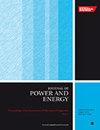优化以乙炔为燃料的 DI 柴油发动机的歧管喷射系统
IF 1.1
4区 工程技术
Q3 ENGINEERING, MECHANICAL
Proceedings of the Institution of Mechanical Engineers, Part A: Journal of Power and Energy
Pub Date : 2024-07-23
DOI:10.1177/09576509241264441
引用次数: 0
摘要
研究人员证明,采用新的燃烧技术和优化燃料数量,可以显著减少传统化石燃料的使用量和排放水平。反应控制压缩点火(RCCI)燃烧策略是低温燃烧技术之一,用于降低整体燃烧温度,同时提供更好的燃烧控制。本研究探讨了 RCCI 燃烧技术,该技术使用传统柴油作为高活性燃料(HRF),通过喷油器喷入气缸;使用乙炔气作为低活性燃料(LRF),通过改进的进气歧管与空气一起喷入气缸。对改进后的发动机装置进行了性能、排放和各种负载条件下的燃烧测试,并对乙炔气(一种与空气一起喷射的低活性燃料)的不同质量流量进行了测试。利用计算流体动力学原理分析了低活性燃料在进气歧管处的流场,从而确定了改善燃烧质量的最佳流速。根据模拟结果,最佳乙炔流速为 3 升/分钟(LPM),实验表明,在 3 LPM 乙炔喷射速度下,制动热效率(BTE)提高了约 3.2%,一氧化碳(CO)、碳氢化合物(HC)、烟雾强度和氮氧化物(NOx)等排放物分别减少了约 35%、17%、10% 和 21%。本文章由计算机程序翻译,如有差异,请以英文原文为准。
Optimization on manifold injection in DI diesel engine fuelled with acetylene
Researchers demonstrated that implementing new combustion technology and optimising fuel quantity results in a significant reduction in traditional fossil fuel usage and emission levels. The Reactivity Controlled Compression Ignition (RCCI) combustion strategy is one of the low temperature combustion technologies, and it is used to reduce the overall combustion temperature while also providing better combustion control. This study looks into RCCI combustion technology, which uses conventional diesel fuel as the high reactivity fuel (HRF) injected through the injector and acetylene gas as the low reactivity fuel (LRF) injected into the cylinder via a modified inlet manifold alongside air. The modified engine setup was tested for performance, emissions, and combustion under various load conditions, as well as different mass flow rates of acetylene gas, a low reactivity fuel that is injected with air. The flow field of the low reactivity fuel at the inlet manifold is analysed using the Computational Fluid Dynamics principle, which is used to determine the best flow rate for improving combustion quality. According to the simulation results, the optimal acetylene flow rate is 3 Litres Per Minute (LPM), and experimentation shows that at 3 LPM acetylene injection, the brake thermal efficiency (BTE) improves by about 3.2%, and emissions such as carbon monoxide (CO), hydrocarbon (HC), smoke intensity, and oxides of nitrogen (NOx) are reduced by about 35%, 17%, 10%, and 21%, respectively.
求助全文
通过发布文献求助,成功后即可免费获取论文全文。
去求助
来源期刊

CiteScore
3.30
自引率
5.90%
发文量
114
审稿时长
5.4 months
期刊介绍:
The Journal of Power and Energy, Part A of the Proceedings of the Institution of Mechanical Engineers, is dedicated to publishing peer-reviewed papers of high scientific quality on all aspects of the technology of energy conversion systems.
 求助内容:
求助内容: 应助结果提醒方式:
应助结果提醒方式:


